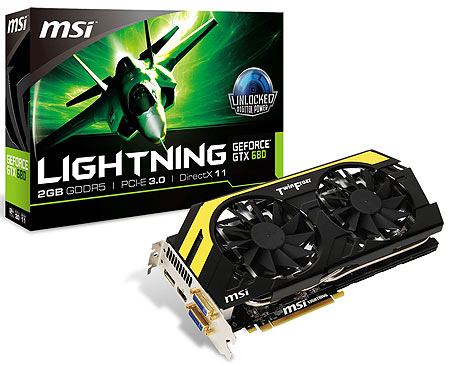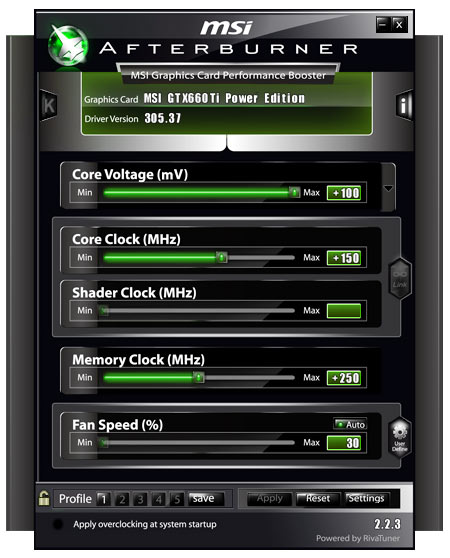GeForce GTX 660 Ti Review: Nvidia's Trickle-Down Keplernomics
Nvidia's Kepler architecture is finally manifest in a $300 graphics card, which the company says beats AMD's Radeon HD 7870 and challenges its more expensive 7950. Can this GK104-based mainstream card carve out a spot between the GCN-based competition?
Test Setup And Benchmarks
The closest-performing card to the GeForce GTX 660 Ti in Nvidia’s prior-generation line-up is GeForce GTX 580. So, we obviously wanted to include it in our tests. Of course, we also want to see how this new model compares to GeForce GTX 670 as well.
AMD's similarly-priced Radeon HD 7870 is an obvious contender, as is the more expensive Radeon HD 7950. We're throwing the Radeon HD 7970 in as a reference point, too. We had MSI's R7970 Lightning and R7950 on-hand to represent those two products, and we dropped each card's clock rates to reference levels. MSI supplied the GeForce GTX 680 Lightning specifically for this review, and we tested it at stock and factory overclocked settings, too.
From here, things get more complicated. AMD is attempting a preemptive strike against GeForce GTX 660 Ti in the form of Radeon HD 7950 Boost Edition. Essentially, this is a BIOS update to the vanilla Radeon HD 7950 that overclocks the board from 800 to 850 MHz and implements a 925 MHz boost state. The accelerated frequency is adjustable in the Catalyst Control Center's overdrive tool.
We’re not going to spend a lot of time talking about the Radeon HD 7950 Boost Edition because, frankly, we're not fans of such last-minute retaliations. Company representatives claim 7950 Boost Edition cards will be available by Friday. But the last time we were promised availability of a Boost Edition card (the 7970), AMD was about a month too ambitious. We'll believe this one when we see it. You'll find the card's results in our overclocking tests as a result.
Speaking of overclocking, we're including MSI’s GeForce GTX 660 Ti a second time, its core accelerated an impressive 150 MHz and memory running 250 MHz faster thanks to MSI's Afterburner tool. We were able dial in an extra 100 millivolts on the core and set 114% of the maximum board power in order to get there.
Finally, we are looking to find the highest playable settings in each game that deliver a minimum of 30 FPS and an average of at least 40. We don't want to waste GPU performance on rendering hundreds of frames per second, and we aren't interested in numbers that aren't playable.
| Test System | |
|---|---|
| CPU | Intel Core i7-3960X (Sandy Bridge-E), 3.3 GHz, Six Cores, LGA 2011, 15 MB Shared L3 Cache, Hyper-Threading enabled, Overclocked to 4.2 GHz |
| Motherboard | ASRock X79 Extreme9 (LGA 2011) Chipset: Intel X79 Express |
| Networking | On-Board Gigabit LAN controller |
| Memory | Corsair Vengeance LP PC3-16000, 4 x 4 GB, 1600 MT/s, CL 8-8-8-24-2T |
| Graphics | Zotac GeForce GTX 580 AMP2 Edition815 MHz GPU, 3 GB GDDR5 at 1025 MHzMSI GeForce GTX 660 Ti1019/1097 MHz Base/Boost GPU, 2 GB GDDR5 at 1502 MHzGigabyte GeForce GTX 670 Overclocked980/1058 MHz Base/Boost GPU, 2 GB GDDR5 at 1502 MHzReference Radeon HD 78701000 MHz GPU, 2 GB GDDR5 at 1200 MHzMSI Radeon R7950800 MHz GPU, 3 GB GDDR5 at 1250 MHzReference Radeon HD 7950 Boost Edition850/925 MHz Base/Boost GPU, 3 GB GDDR5 at 1250 MHzMSI Radeon R7970 Lightning925 MHz GPU, 3 GB GDDR5 at 1375 MHzAll overclocked cards reduced to reference specification for testing |
| Hard Drive | Samsung 256 GB (SSD) |
| Power | ePower EP-1200E10-T2 1200 W ATX12V, EPS12V |
| Software and Drivers | |
| Operating System | Microsoft Windows 7 x64, Service Pack 1 |
| DirectX | DirectX 11 |
| Graphics Drivers | Nvidia: 305.37 betaAMD: Catalyst 12.7 beta |
| Benchmarks | |
| Battlefield 3 | Campaign Mode, "Operation Swordfish" 60 second Fraps |
| Crysis 2 | Adrenaline Crysis 2 Benchmark Tool 1.0.1.13, Times Square, DirectX 11 |
| Batman: Arkham Asylum | Version 1.0.0.0, Built-in DirectX 11 Benchmark |
| Metro 2033 | Full Game, Built-In Benchmark, "Frontline" Scene |
| DiRT Showdown | Version 1.0.0.0, DirectX 11 Benchmark |
| The Elder Scrolls V: Skyrim | Update 1.4.27, THG Benchmarks save, 25 seconds Fraps |
| Max Payne 3 | Version 1.0.0.4.7, Chapter 3, save 16, 65 second Fraps |
Get Tom's Hardware's best news and in-depth reviews, straight to your inbox.
Current page: Test Setup And Benchmarks
Prev Page The Kepler Trickle-Down Continues Next Page Benchmark Results: Batman: Arkham CityDon Woligroski was a former senior hardware editor for Tom's Hardware. He has covered a wide range of PC hardware topics, including CPUs, GPUs, system building, and emerging technologies.
-
game junky Hmm. I have been wanting to replace my 560 - this throws a wrench in the gears. I was sold on a ASUS 670 but I think I'll wait to compare specs with their 660ti - I just started ripping my BD collection so the additional RAM bandwidth might be worth the extra $100 but it is still an interesting option.Reply -
crisan_tiberiu so, this is basically a card that costs 40$ less then a GTX 580, consumes 100W less power then a gtx 580 and its 8% better...hmm, intresting.Reply -
rmpumper That's strange - on techpowerup review the 660Ti is above 7950's average performance.Reply -
outlw6669 game junkyI was sold on a ASUS 670 but I think I'll wait to compare specs with their 660ti.Asus' DCU2 Top ends up about 5% faster than stock, 8% slower than stock GTX 670 and still uses that excellent cooler.Reply
http://www.techpowerup.com/reviews/ASUS/GeForce_GTX_660_Ti_Direct_Cu_II/1.html
Still, the GTX 660Ti looks to be a decent card.
Not really fond of how nVidia keeps nerfing their memory bandwidth though.
Once prices drop a little, I could see it being an excellent mainstream card. -
verbalizer nice card, not OVERLY impressed...Reply
BUT THE PRICE...!
c'mon SON let's be real here......
ridiculous @ $300 beans.. -
felipetga I have been holding to upgrade my GTX 460 256bits. I wonder if this card will be bottlenecked by my C2Q 9550 @ 3.6ghz....Reply -
verbalizer GPGPU = Kepler = FAIL....Reply
that's depressing but I understand nVidia has designated GTX 6 series as a gaming cards but c'mon SON.!!!
ridiculous once again.. -
EzioAs Clearly we need more price cuts on the 660ti. I expect AMD to lower the prices even more, heck online retailers sell Radeon cards lower than the MSRP, making 7950 and 7870 even more budget friendly. It's still sad really to see mid-range cards battling at $300+. It used to be $250 and lowerReply

